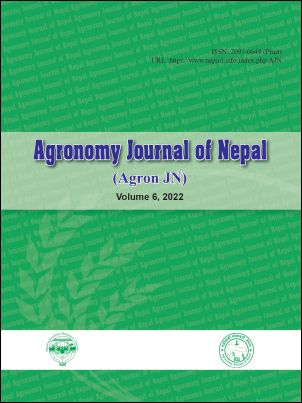Response of Different Levels of Nitrogen and Plant Population to Grain Yield of Winter Hybrid Maize in Chitwan Valley
DOI:
https://doi.org/10.3126/ajn.v6i1.47938Keywords:
Hybrid maize, nitrogen, plant population, grain yieldAbstract
A field experiment on “Performance of hybrid maize under different levels of nitrogen and plant population” was conducted in Randomized complete block design (RCBD) at the research farm of the National Maize Research Program (NMRP), Rampur, Chitwan during the winter season of 2015/16 to determine the optimum level of nitrogen and plant population for winter season hybrid maize. The grain yield (2.38 Mt ha-1) obtained in control without nitrogen was significantly lower in comparison to its all other levels (70, 140 and 210 Kg N ha-1). Moreover, grain yield (5.45 Mt ha-1) produced by the application 210 Kg N ha-1 was significantly superior over 70 Kg N ha-1 (3.83 Mt ha-1) but remained at par with 140 Kg N ha-1 (5.02 Mt ha-1) which also differed significantly. Moreover, the grain yield (4.98 Mt ha-1) recorded with the population of 101010 plants ha-1 was significantly superior over 55,555 (3.34 Mt ha-1) and 69,444 (3.90 Mt ha-1) plants ha-1 but similar to that of 85,470 plants ha-1 (4.46 Mt ha-1) which was also significantly higher as compared to 69,444 and 55,555 plants ha-1 which were at par with each other. Regression analysis for the effect of nitrogen and plant population on grain yield showed the grain yield was 145 Kg N ha-1 and plant population was 87445 plants ha-1. Thus, hybrid maize (RML95/RML96) can be successfully grown by applying 145 Kg N ha-1 and maintaining a population of 87 thousand plants ha-1 to achieve a higher grain yield during the winter season.
Downloads
Downloads
Published
How to Cite
Issue
Section
License
Copyright (c) 2022 Agronomy Society of Nepal (ASoN)

This work is licensed under a Creative Commons Attribution-NonCommercial 4.0 International License.
ASON permits for free use, distribution and reproduction in any medium if the original work is properly cited and not used for commercial purposes.




